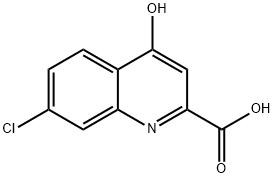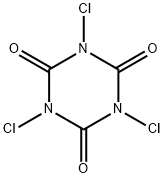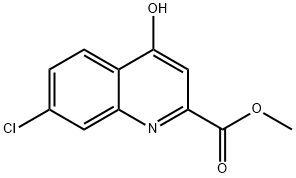7-CHLORO-4-HYDROXYQUINOLINE-2-CARBOXYLIC ACID HCL
Synonym(s):7-Chloro-4-hydroxyquinoline-2-carboxylic acid;7-Cl-KYNA
- CAS NO.:18000-24-3
- Empirical Formula: C10H6ClNO3
- Molecular Weight: 223.61
- MDL number: MFCD00069227
- EINECS: 241-913-6
- SAFETY DATA SHEET (SDS)
- Update Date: 2025-12-07 19:09:50

What is 7-CHLORO-4-HYDROXYQUINOLINE-2-CARBOXYLIC ACID HCL?
The Uses of 7-CHLORO-4-HYDROXYQUINOLINE-2-CARBOXYLIC ACID HCL
NMDA receptor antagonist at the glycine site
What are the applications of Application
7-Chlorokynurenic acid is an NMDA receptor antagonist and inhibitor of EAAT
Definition
ChEBI: A quinolinemonocarboxylic acid that is quinaldic acid which is substituted by a hydroxy group at position 4 and by a chlorine at position 7. It is a potent NMDA glutamate receptor antagonist which antagonizes the strychnine-insensitive glycine site of the MDA receptor. It also prevents neurodegeneration produced by quinolinic acid.
Biological Functions
Glycine B agonist site antagonist of N-methyl-D-aspartate (NMDA) receptor (IC50=0.56 μM). 7-Chlorokynurenic acid is also a potent inhibitor of glutamate reuptake into synaptic vesicles with a Ki of 0.59 μM. 7-Chlorokynurenic acid has potent analgesic effects in neurotransmission.
Biological Activity
NMDA receptor antagonist acting at the glycine site. Potent competitive inhibitor of L-glutamate transport into synaptic vesicles. Also available as part of the NMDA Receptor - Glycine Site Tocriset™ .
in vivo
Male Sprague-Dawley rats pretreated with 7-Chlorokynurenic acid (10 nM) shows a significant retardation of development of both the electroencephalographic and motor (17.7±2.9 daily stimulations) components of the seizure response.
Storage
Room temperature
Properties of 7-CHLORO-4-HYDROXYQUINOLINE-2-CARBOXYLIC ACID HCL
| Melting point: | 277-278 °C (decomp) |
| Boiling point: | 461.5±45.0 °C(Predicted) |
| Density | 1.600±0.06 g/cm3(Predicted) |
| storage temp. | Sealed in dry,Room Temperature |
| solubility | 0.1 M NaOH: 13.7 mg/mL |
| form | solid |
| pka | 0.90±0.30(Predicted) |
| color | tan |
| CAS DataBase Reference | 18000-24-3(CAS DataBase Reference) |
Safety information for 7-CHLORO-4-HYDROXYQUINOLINE-2-CARBOXYLIC ACID HCL
| Signal word | Warning |
| Pictogram(s) |
 Exclamation Mark Irritant GHS07 |
| GHS Hazard Statements |
H302:Acute toxicity,oral H315:Skin corrosion/irritation H319:Serious eye damage/eye irritation H335:Specific target organ toxicity, single exposure;Respiratory tract irritation |
| Precautionary Statement Codes |
P261:Avoid breathing dust/fume/gas/mist/vapours/spray. P280:Wear protective gloves/protective clothing/eye protection/face protection. P301+P312:IF SWALLOWED: call a POISON CENTER or doctor/physician IF you feel unwell. P302+P352:IF ON SKIN: wash with plenty of soap and water. P305+P351+P338:IF IN EYES: Rinse cautiously with water for several minutes. Remove contact lenses, if present and easy to do. Continuerinsing. |
Computed Descriptors for 7-CHLORO-4-HYDROXYQUINOLINE-2-CARBOXYLIC ACID HCL
New Products
Indole Methyl Resin tert-butyl 9-methoxy-3-azaspiro[5.5]undecane-3-carboxylate Boc-His(Boc)-OH 2-CTC Resin 4-Chloro-7-tosy1-7Hpyrrolo[2,3-d]pyrimidine 5,7-Dibromo-1H-indole 2,5-dichloro-N-hydroxy-4,6-dimethylpyridine-3-carboximidamide 2,2-Dimethoxy-7-azaspiro[3.5]nonane hydrochloride 4-chloromethyl-5-methyl-1,3-dioxol-2-one (DMDO-Cl) R-2-BENZYLOXY PROPIONIC ACID 1,1’-CARBONYLDIIMIDAZOLE 1,1’-CARBONYLDI (1,2-4 TRIAZOLE) N-METHYL INDAZOLE-3-CARBOXYLIC ACID 4-((2-hydroxyethyl)thio)benzoic acid 1-(TERT-BUTOXYCARBONYL)-2-PYRROLIDINONE Methyl 6-methylnicotinate 3-Pyridineacrylic acid tert-Butyl carbazate TETRAHYDRO-2H-PYRAN-3-OL 2-((4-morpholinophenylamino) (methylthio) methylene) malononitrile 3-(4-morpholinophenylamino)-5-amino-1H-pyrazole-4-carbonitrile 2,4-dihydroxybenzaldehyde 1,3-Diethyl-1,3-Diphenylurea Methyl 2-methylquinoline-6-carboxylateRelated products of tetrahydrofuran

![DICHLOROKYNURENIC ACID, 5,7-[3-3H]-](https://img.chemicalbook.in/StructureFile/ChemBookStructure2/GIF/CB4219062.gif)





You may like
-
 Pyridine 99.5% HPLC /UV SpectroscopyView Details
Pyridine 99.5% HPLC /UV SpectroscopyView Details
110-86-1 -
 Guanine , 99%View Details
Guanine , 99%View Details
73-40-5 -
 Piperazine Spot supply, best priceView Details
Piperazine Spot supply, best priceView Details
110-85-0 -
 Potassium Hydroxide 90%View Details
Potassium Hydroxide 90%View Details
1310-58-3 -
 Dibutyl PhthalateView Details
Dibutyl PhthalateView Details
84-74-2 -
 Imidazole Spot supply, competitive priceView Details
Imidazole Spot supply, competitive priceView Details
288-32-4 -
 Octadecyl 3-(3,5-di-tert-butyl-4-hydroxyphenyl)propionate 98% (GC)View Details
Octadecyl 3-(3,5-di-tert-butyl-4-hydroxyphenyl)propionate 98% (GC)View Details
2082-79-3 -
 Thiourea 99% ARView Details
Thiourea 99% ARView Details
62-56-6
